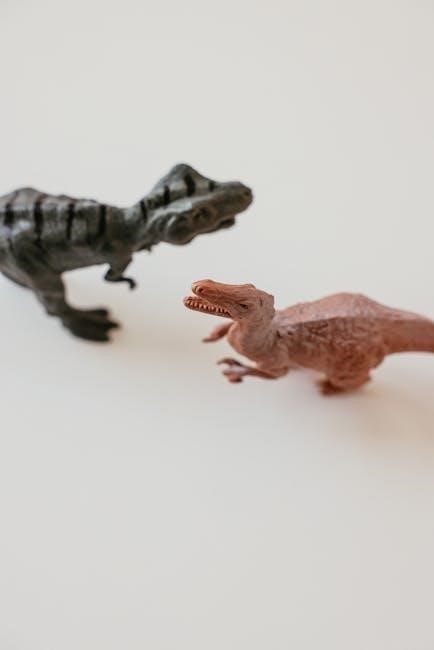
Dinosaur PDFs: A Comprehensive Guide
Dive into the prehistoric world with readily available dinosaur PDF resources, offering educational fun for all ages! These digital documents present a fantastic way to explore these ancient creatures․
Numerous PDF packs, like the 15-resource collection for PreK and kindergarten, provide engaging activities encompassing reading, vocabulary, spelling, and creative expression․

Discover comprehensive materials detailing dinosaur history, fossil types, and paleontological identification methods, all conveniently formatted for easy access and learning․
Dinosaur PDFs represent a dynamic and accessible gateway to learning about these magnificent prehistoric creatures․ These digital documents are transforming how educators, parents, and enthusiasts engage with paleontology, offering a wealth of information at your fingertips․
From comprehensive guides detailing dinosaur history to engaging worksheets for young learners, PDF format ensures easy distribution and printing․ The convenience of PDFs allows for flexible learning, whether at home, in the classroom, or during travel․
These resources often include vibrant illustrations, detailed fossil information, and interactive activities, making the learning experience both informative and enjoyable․ PDFs cater to diverse age groups and learning styles, providing tailored content for PreK students through advanced learners․ Explore a world of dinosaur discovery today!
What are Dinosaur PDFs?
Dinosaur PDFs are digital files, typically in the Portable Document Format, containing information about dinosaurs․ They encompass a broad spectrum of content, ranging from educational worksheets and coloring pages to in-depth scientific articles and comprehensive guides;
These files are designed for easy viewing and printing across various devices, ensuring accessibility for a wide audience․ A PDF can be a single page worksheet, like those focusing on dinosaur vocabulary, or a multi-page document detailing the Triassic, Jurassic, and Cretaceous periods․
Essentially, dinosaur PDFs serve as a versatile medium for disseminating paleontological knowledge, offering a convenient and cost-effective way to learn about these fascinating prehistoric reptiles and their world․
Why Use Dinosaur PDFs for Learning?
Dinosaur PDFs offer a uniquely engaging and accessible learning experience․ They provide a convenient, printable format, ideal for both classroom and home education, eliminating the need for constant internet access․
These resources cater to diverse learning styles, with options like coloring pages fostering creativity, worksheets reinforcing vocabulary and spelling, and detailed reading materials promoting comprehension․
Furthermore, PDFs often present information in a visually appealing manner, capturing children’s attention and sparking their curiosity about paleontology․ They are a cost-effective alternative to physical books, and readily available for various age groups, from PreK to older students․

Dinosaur History and Paleontology
Explore the Mesozoic Era through PDF resources, detailing the Triassic, Jurassic, and Cretaceous periods, alongside fossil types and paleontological identification techniques․
The Triassic, Jurassic, and Cretaceous Periods
Dinosaur PDF resources vividly illustrate the vast timescales of the Mesozoic Era, broken down into the Triassic, Jurassic, and Cretaceous periods․ These documents detail how dinosaurs initially emerged and diversified during the Triassic period, approximately 230 million years ago, alongside other early reptiles․
Further PDF explorations reveal the Jurassic period as a golden age for dinosaurs, showcasing iconic giants like Brachiosaurus and Stegosaurus․ The Cretaceous period, the final chapter, witnessed the rise of Tyrannosaurus Rex and the eventual extinction event approximately 65 million years ago․

Many educational PDFs present timelines and charts, visually representing these periods and the evolutionary changes within dinosaur populations, offering a comprehensive understanding of their reign on Earth․
Dinosaur Fossil Types
Dinosaur PDF guides comprehensively explain the three primary types of fossils crucial to paleontological study: body fossils, trace fossils, and resin fossils․ PDF resources detail how body fossils – preserved remains of dinosaur bones, teeth, and even skin – provide direct evidence of their anatomy and size․
Trace fossils, also thoroughly covered in these PDFs, include footprints, trackways, and coprolites (fossilized dung), revealing insights into dinosaur behavior and movement․ Resin fossils, or amber, occasionally preserve small dinosaur remains, offering exceptional preservation of soft tissues․
Educational PDFs often include diagrams and illustrations showcasing each fossil type, explaining how paleontologists analyze them to reconstruct dinosaur life and ecosystems, providing a fascinating glimpse into the past․
Body Fossils
Dinosaur PDF resources dedicate significant attention to body fossils, the most recognizable type of dinosaur remains․ These PDFs explain that body fossils encompass preserved bones, teeth, claws, and, rarely, even skin impressions or entire skeletons․
Detailed diagrams within these guides illustrate how paleontologists excavate, clean, and study these fossils to determine a dinosaur’s size, shape, and anatomical features․ PDFs often showcase examples of famous body fossil discoveries, like complete Tyrannosaurus rex skeletons․
Furthermore, these educational materials explain the process of fossilization, detailing how organic material is replaced by minerals over millions of years, creating durable, lasting records of prehistoric life, readily available in PDF format․
Trace Fossils
Dinosaur PDF guides highlight trace fossils as invaluable sources of information, even without preserved body parts․ These PDFs explain that trace fossils aren’t the remains of the dinosaur itself, but evidence of its activity․ This includes footprints, trackways, burrows, and even fossilized dung (coprolites)․
Educational PDFs demonstrate how paleontologists analyze these traces to understand dinosaur behavior – how they moved, hunted, interacted with each other, and their environment․ Trackways, for example, reveal walking speed and herd dynamics․
Many PDF resources include illustrations of different dinosaur footprints, helping learners identify potential species based on track morphology․ These materials emphasize that trace fossils offer unique insights complementing body fossil discoveries․
Resin Fossils
Dinosaur PDF resources explain that resin fossils, also known as amber fossils, are exceptionally rare and valuable․ These PDF guides detail how, millions of years ago, sticky tree resin encased small organisms – occasionally including dinosaur remains like feathers, skin, or even tiny bones․
Educational PDFs showcase stunning images of inclusions preserved within amber, offering a window into the dinosaur age․ The resin hardens over time, protecting the enclosed material from decay, providing remarkably detailed preservation․
These PDF materials emphasize that amber fossils are unique because they can preserve soft tissues, which rarely fossilize through other methods․ They offer insights into dinosaur coloration, feather structure, and skin texture, supplementing skeletal discoveries․
How Paleontologists Identify Dinosaurs
Dinosaur PDFs comprehensively explain the meticulous process paleontologists use to identify these prehistoric creatures․ These resources detail how scientists analyze fossilized bones, comparing their shapes, sizes, and structures to known dinosaur species․
Educational PDF guides illustrate how paleontologists examine features like teeth, limb bones, and skull characteristics to determine a dinosaur’s diet, locomotion, and evolutionary relationships․ Comparative anatomy is key, utilizing extensive databases and established classifications․
Many PDFs highlight the importance of considering multiple fossil specimens from the same species to account for individual variations․ They also explain how paleontologists use cladistics – a method of analyzing shared characteristics – to build evolutionary trees and understand dinosaur lineages․

Types of Dinosaurs
Dinosaur PDFs categorize these creatures, explaining classifications and groups like herbivorous, carnivorous, and omnivorous types, offering detailed insights into dinosaur diversity!

Classifying Dinosaurs
Dinosaur PDF resources expertly demonstrate how paleontologists classify these magnificent creatures, much like organizing LEGO bricks by shape and size․ These digital guides explain that classifying dinosaurs involves grouping them based on shared characteristics, aiding in understanding their evolutionary relationships․
PDF materials often detail the two primary dinosaur groups: Saurischia (lizard-hipped) and Ornithischia (bird-hipped)․ These classifications are based on the structure of their hip bones, a key feature in paleontological analysis․
Furthermore, PDFs illustrate how dinosaurs are categorized within these groups, considering factors like diet, anatomy, and evolutionary lineage․ This systematic approach, presented in accessible PDF formats, makes learning about dinosaur taxonomy engaging and informative for all ages․
Popular Dinosaur Groups
Dinosaur PDFs frequently spotlight popular groups, offering detailed insights into their unique characteristics and lifestyles․ These resources commonly feature herbivorous dinosaurs like the Brachiosaurus and Triceratops, showcasing their plant-based diets and physical adaptations for consuming vegetation․
Carnivorous dinosaurs, such as the Tyrannosaurus Rex and Velociraptor, are also prominently featured, with PDFs detailing their predatory behaviors, sharp teeth, and powerful claws․ These materials often include illustrations and factual information about their hunting strategies․
Additionally, some PDFs explore omnivorous dinosaurs, highlighting their varied diets and adaptability․ These resources provide a comprehensive overview of dinosaur diversity, making learning about these prehistoric creatures both educational and exciting․
Herbivorous Dinosaurs
Dinosaur PDFs dedicated to herbivorous dinosaurs often showcase giants like the Brachiosaurus, emphasizing their long necks for reaching high vegetation and massive sizes․ These resources detail their specialized teeth, designed for grinding plant matter, and large stomachs for efficient digestion․
Triceratops is another frequent focus, with PDFs illustrating their distinctive frills and horns, potentially used for display or defense․ Information often covers their diet of low-lying plants and social behaviors within herds․
Many PDFs include diagrams illustrating the digestive systems of these plant-eaters, explaining how they processed tough vegetation․ Interactive worksheets within these PDFs may challenge learners to identify different plant species consumed by these magnificent creatures․
Carnivorous Dinosaurs
Dinosaur PDFs frequently spotlight apex predators like Tyrannosaurus Rex, detailing their powerful jaws, serrated teeth, and binocular vision for hunting․ These resources often include illustrations of their muscular builds and short arms, sparking discussions about their hunting strategies․
Velociraptor is another popular subject, with PDFs showcasing their sickle-shaped claws and agile builds, emphasizing their pack-hunting behaviors․ Diagrams often illustrate their skeletal structure and potential feathering․
Educational PDFs may include comparisons of carnivorous dinosaur teeth to modern predators, highlighting adaptations for tearing flesh․ Interactive activities within these PDFs could involve identifying prey animals or reconstructing a hunting scene, fostering a deeper understanding of these formidable creatures․
Omnivorous Dinosaurs
Dinosaur PDF resources are increasingly highlighting the complexity of dinosaur diets, including those of omnivores․ These documents often feature Ornithomimus, showcasing its long legs and beak, suggesting a diet of plants, insects, and small animals․
PDFs dedicated to omnivores explore the challenges paleontologists face in determining diet based on fossil evidence, discussing coprolite analysis (fossilized dung) and tooth wear patterns․ Illustrations demonstrate potential food sources, like fruits, seeds, and small vertebrates․
Interactive PDF activities might involve sorting food items into categories for different omnivorous dinosaurs, or reconstructing a scene depicting their varied feeding habits․ These resources emphasize that not all dinosaurs fit neatly into herbivore or carnivore classifications, promoting a nuanced understanding of prehistoric ecosystems․
Dinosaur Features and Characteristics
Dinosaur PDFs vividly illustrate unique features, detailing sizes, shapes, teeth, claws, and adaptations! Explore paleontological insights into these prehistoric marvels through detailed diagrams․
Dinosaur Sizes and Shapes
Dinosaur PDF resources excel at visually demonstrating the incredible range of sizes and shapes exhibited by these prehistoric creatures․ Many PDFs include comparative charts, allowing students to grasp the scale difference between giants like the Argentinosaurus and smaller dinosaurs like Compsognathus․
Detailed illustrations within these documents showcase diverse body plans – from the long necks of sauropods to the armored plates of stegosaurs and the bipedal stance of theropods․ Worksheets often challenge learners to describe dinosaur shapes using adjectives, fostering observational skills․
Furthermore, some PDFs incorporate activities where children estimate dinosaur sizes relative to familiar objects, enhancing their understanding of scale and proportion․ These visual aids, readily available in PDF format, bring the world of dinosaurs to life, making learning both engaging and informative․
Dinosaur Teeth and Claws
Dinosaur PDFs provide detailed explorations of dinosaur dentition and claw structures, crucial for understanding their diets and lifestyles․ Many resources feature close-up illustrations of various teeth – the sharp, serrated teeth of carnivores like Tyrannosaurus Rex, contrasted with the flat, grinding teeth of herbivores like Triceratops․
Educational PDFs often include diagrams explaining how different tooth shapes aided in processing food․ Similarly, claw morphology is examined, highlighting the curved, sharp claws used for predation versus the blunt claws used for digging or defense․
Interactive worksheets within these PDFs challenge students to match dinosaurs to their appropriate teeth or claw types, reinforcing learning․ These resources effectively demonstrate how these features were key adaptations for survival in the prehistoric world, offering a fascinating glimpse into dinosaur biology․
Unique Dinosaur Adaptations
Dinosaur PDF resources excel at showcasing the remarkable adaptations that allowed these creatures to thrive․ Many PDFs dedicate sections to explaining how dinosaurs evolved specific traits to overcome environmental challenges and survive․
Detailed illustrations and informative text within these documents highlight features like the Stegosaurus’ plates for thermoregulation or the Ankylosaurus’ armored body for defense․ Some PDFs explore the potential functions of dinosaur crests and frills, suggesting roles in display or communication․
Interactive activities, often included in these PDFs, encourage students to identify adaptations and hypothesize their purposes․ These resources effectively demonstrate the power of natural selection and the incredible diversity of life during the Mesozoic Era, fostering a deeper understanding of evolutionary principles․
Dinosaur PDF Resources for Education

Explore a wealth of dinosaur PDFs, including worksheets, reading materials, and coloring pages, designed to ignite young learners’ passion for paleontology!
Dinosaur Worksheets for PreK and Kindergarten

Engaging dinosaur worksheets in PDF format are specifically tailored for Pre-Kindergarten and Kindergarten students, offering a playful introduction to these prehistoric giants․ These resources are designed to foster early learning skills through a variety of captivating activities․
Many packs, such as the one boasting 15 colorful resources, incorporate reading comprehension exercises, vocabulary building, and spelling practice, all centered around the fascinating world of dinosaurs․ These worksheets aren’t just about memorization; they encourage creativity and critical thinking․
Activities often include matching games, coloring pages, simple puzzles, and tracing exercises, helping to develop fine motor skills alongside paleontological knowledge․ The PDF format ensures easy printing and accessibility for both classroom and home learning environments, making dinosaur education convenient and fun!
Dinosaur Reading Materials in PDF Format
Numerous PDF documents offer captivating reading materials about dinosaurs, suitable for a range of reading levels․ These resources transform learning into an adventure, bringing the prehistoric world to life through informative text and engaging narratives․
Many PDFs present factual information about different dinosaur species, their habitats, diets, and behaviors, often accompanied by vibrant illustrations․ These materials are excellent for building comprehension skills and expanding a child’s knowledge of paleontology․
Furthermore, some PDFs include short stories or fictional accounts featuring dinosaurs, sparking imagination and a love for reading․ The convenient PDF format allows for easy access on various devices, promoting independent learning and exploration of these magnificent creatures, fostering a lifelong passion for science․
Dinosaur Coloring Pages (PDF)
Dinosaur coloring pages in PDF format provide a fantastic and engaging activity for children of all ages, blending creativity with prehistoric learning․ These downloadable resources offer a diverse range of dinosaur illustrations, from the mighty Tyrannosaurus Rex to the gentle Brachiosaurus․
The PDF format ensures easy printing and accessibility, allowing kids to enjoy hours of coloring fun․ Coloring enhances fine motor skills, hand-eye coordination, and color recognition, all while fostering a deeper appreciation for these ancient creatures․
Beyond simple entertainment, these pages can be integrated into educational activities, prompting discussions about different dinosaur species and their characteristics․ They offer a relaxing and imaginative outlet, sparking curiosity and a love for paleontology through artistic expression․
Creating Your Own Dinosaur
Unleash your inner paleontologist! PDF resources inspire designing unique dinosaurs, hunting for fascinating facts, and investigating their bodies, teeth, and claws for inspiration․
Designing the Perfect Dinosaur
Embark on a thrilling creative journey by designing your very own dinosaur! Utilizing dinosaur PDF resources as inspiration, consider various features and adaptations․ Think about size – will it be a colossal sauropod or a swift raptor?
Explore different tooth and claw structures; sharp, serrated teeth for a carnivore, or flat, grinding teeth for an herbivore? PDF materials detailing dinosaur features will prove invaluable․ What unique adaptations will your dinosaur possess? Perhaps camouflage, armored plates, or a powerful tail?
Consider its habitat and lifestyle․ Will it roam forests, plains, or swamps? PDF learning materials can help you understand how environment shapes evolution․ Document your design, noting its characteristics and explaining the reasoning behind your choices․ This process blends creativity with scientific exploration!
Dinosaur Fact Hunting

Embark on an exciting paleontological quest – a dinosaur fact hunt! Utilizing dinosaur PDF resources, become a junior researcher uncovering fascinating details about these prehistoric creatures; Begin by selecting a specific dinosaur or group, then delve into the available PDF materials․
Focus on key characteristics: size, diet, habitat, and unique adaptations․ What did its teeth look like, and what does that tell you about its eating habits? Which period did it live in – Triassic, Jurassic, or Cretaceous? PDFs offer a wealth of information!
Record your findings meticulously, creating a detailed fact file․ Compare information from different PDF sources to ensure accuracy․ This activity fosters critical thinking and research skills, transforming learning into an engaging adventure․

Where to Find Dinosaur PDFs Online
Explore numerous websites offering dinosaur PDFs, ranging from free worksheets to comprehensive educational packs; ensure quality and accuracy when selecting resources․
Reputable Sources for Dinosaur PDFs
Finding reliable dinosaur PDF resources requires careful consideration of the source․ Several websites consistently offer high-quality, accurate materials suitable for various age groups and learning levels․
Educational platforms like Teachers Pay Teachers host a wide array of dinosaur-themed worksheets, reading passages, and coloring pages, often created by experienced educators․ These resources frequently come with detailed answer keys and learning objectives․
Museum websites, such as those of the American Museum of Natural History or the Smithsonian National Museum of Natural History, often provide downloadable PDFs related to their exhibits and research․ These are generally vetted by paleontologists and offer scientifically sound information․
Additionally, websites dedicated to homeschooling or educational printables, like Twinkl or Education․com, feature extensive collections of dinosaur PDFs, categorized by grade level and skill․ Always preview the content to ensure it aligns with your educational goals․
Free vs․ Paid Dinosaur PDF Resources
The availability of dinosaur PDFs spans a spectrum from free to premium paid options, each with distinct advantages․ Free resources, often found on museum websites or educational blogs, provide accessible introductory materials and basic worksheets․
However, these free PDFs may have limited content or scope․ Paid resources, typically available on platforms like Teachers Pay Teachers, generally offer more comprehensive and detailed materials, including answer keys and differentiated activities․
Premium PDF packs often feature higher-quality graphics, more extensive lesson plans, and a wider range of skill-building exercises․ The cost can vary significantly, depending on the complexity and length of the resource․
Ultimately, the best choice depends on your specific needs and budget․ Free resources are excellent for supplemental learning, while paid options provide a more structured and in-depth educational experience․
Ensuring PDF Quality and Accuracy
When utilizing dinosaur PDFs for educational purposes, verifying both quality and accuracy is paramount․ Not all online resources are created equal, and misinformation can hinder learning․
Prioritize PDFs sourced from reputable institutions like museums, paleontological societies, or established educational publishers․ Cross-reference information with trusted sources to confirm the scientific validity of the content․
Assess the PDF’s clarity and organization․ Well-designed resources will feature clear illustrations, legible fonts, and a logical flow of information․ Look for resources created by educators or paleontologists․
Be cautious of PDFs with grammatical errors, blurry images, or unsubstantiated claims․ A commitment to accuracy ensures a positive and reliable learning experience for students of all ages․
Leave a Reply
You must be logged in to post a comment.